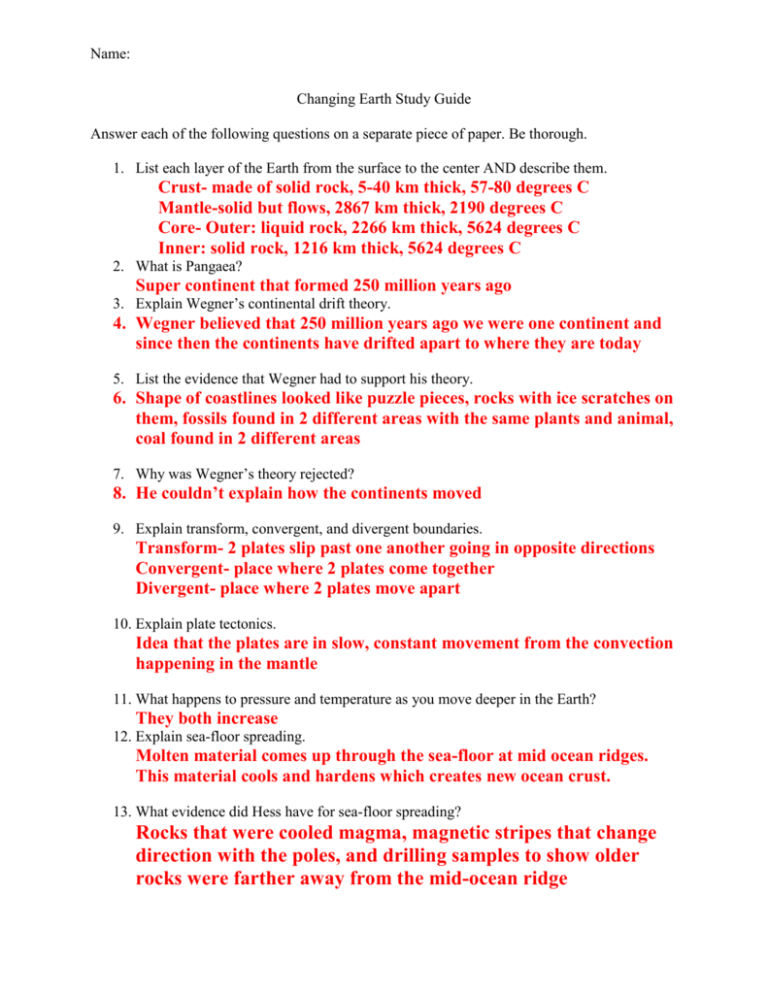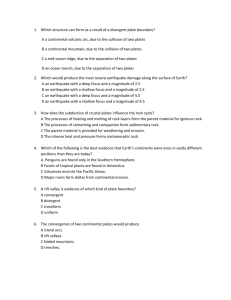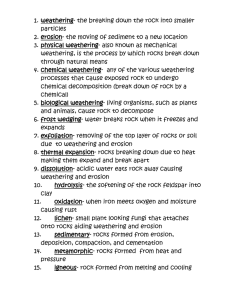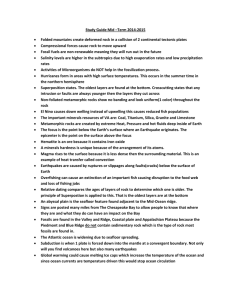Crust- made of solid rock, 5-40 km thick, 57-80 degrees
advertisement

Name: Changing Earth Study Guide Answer each of the following questions on a separate piece of paper. Be thorough. 1. List each layer of the Earth from the surface to the center AND describe them. Crust- made of solid rock, 5-40 km thick, 57-80 degrees C Mantle-solid but flows, 2867 km thick, 2190 degrees C Core- Outer: liquid rock, 2266 km thick, 5624 degrees C Inner: solid rock, 1216 km thick, 5624 degrees C 2. What is Pangaea? Super continent that formed 250 million years ago 3. Explain Wegner’s continental drift theory. 4. Wegner believed that 250 million years ago we were one continent and since then the continents have drifted apart to where they are today 5. List the evidence that Wegner had to support his theory. 6. Shape of coastlines looked like puzzle pieces, rocks with ice scratches on them, fossils found in 2 different areas with the same plants and animal, coal found in 2 different areas 7. Why was Wegner’s theory rejected? 8. He couldn’t explain how the continents moved 9. Explain transform, convergent, and divergent boundaries. Transform- 2 plates slip past one another going in opposite directions Convergent- place where 2 plates come together Divergent- place where 2 plates move apart 10. Explain plate tectonics. Idea that the plates are in slow, constant movement from the convection happening in the mantle 11. What happens to pressure and temperature as you move deeper in the Earth? They both increase 12. Explain sea-floor spreading. Molten material comes up through the sea-floor at mid ocean ridges. This material cools and hardens which creates new ocean crust. 13. What evidence did Hess have for sea-floor spreading? Rocks that were cooled magma, magnetic stripes that change direction with the poles, and drilling samples to show older rocks were farther away from the mid-ocean ridge Name: 14. Explain what happens when 2 ocean plates collide, 2 continental plates collide, and 1 ocean and 1 continental plate collide. 2 ocean plates- more dense plate will sink 2 continental- a mountain forms 1 continental and 1 ocean- the ocean sinks 15. Explain convection currents. Idea that hot material rises due to less density. As it reaches the top, it cools, becomes more dense, and drops back down. It will then heat up and start the process all over. 16. Name and explain the 3 kinds of stress that can occur in the crust. Compression – squeezes rocks until they fold or break, Tension – pulls on the crust making it thinner in the middle, plates move apart Shearing – pushes the mass of rock in opposite directions, rocks break apart, slip apart, or change shape 17. Describe a normal fault. A fault where the hanging wall slides down, Caused by tension in the crust 18. Describe hanging walls and foot walls. Hanging wall – the block of rock that forms the upper half of a fault Foot Wall – the block of rock that forms the lower half of a fault 19. Describe anticlines and synclines. Anticline – an upward fold in rock caused by compression, looks like an Arch Syncline – a downward fold in rock caused by compression, looks like a Smile 20. What is a focus? What is an epicenter? Focus – the point underground where an earthquake starts Epicenter – the point on the surface of the earth directly above the earthquake’s focus 21. Describe P and S waves. P waves – the primary (first) wave the comes from an earthquake, compresses and expands like an accordion S waves – the secondary (second) wave that comes from and earthquake, moves the land up & down or side to side 22. How are the Mercalli and Richter scales different? How are they alike? Both scales rate the strength of an earthquake. The Mercalli scale measures according to the intensity of an earthquake and the amount of damage done in a particular place. The Richter scale measures according to the size of the seismic waves. Name: 23. What is an aftershock? An earthquake that comes after a larger earthquake in the same region. 24. What is the best way to protect yourself in an earthquake? Drop to the ground, cover your head, and hold this position. Try to get under a sturdy piece of furniture like a desk or table. If outdoors, move away from overhead hazards such as trees, power lines, and tall buildings. 25. Explain active, dormant, and extinct volcanoes. Active – currently erupting or shows signs that it may erupt in the near future. Dormant – sleeping, not currently active but could erupt again sometime Extinct – dead, not likely to ever erupt again 26. Explain the difference between magma and lava. Magma is molten material inside of the earth. Lava is molten material on the surface of the earth. They are the same thing but in different locations. 27. Name the 3 kinds of volcanoes and describe how each form. A shield volcano is a wide, gently sloping mountain that is formed by layers of lava that pile up during quiet eruptions. A composite volcano is tall cone shaped mountain where layers of lava alternate with layers of ash and other volcanic materials. A cinder cone volcano is a steep cone shaped mountain made of volcanic ash, cinders, and bombs. 28. Describe relative age and absolute age. Relative age is the age of the rock layer compared to the age of other rocks around it. Absolute age is the age in years. 29. Why do earthquakes and volcanoes often occur in the same area? Both occur along plate boundaries where tectonic plates interact with one another. 30. List the four major eras of Earth’s geologic history and briefly describe what was happening during each era. Precambrian started at Earth’s formation. Earliest life forms developed, multi-cellular marine organisms. VERY few fossils from this era Paleozoic era began 600 million years ago, abundant life in seas and land. First forests developed. Ends with major extinction Mesozoic – Pangaea breaks up, dinosaurs mammals and flowering plants appear, milder temperatures Cenozoic – current era, mammals dominate, several ice ages occurred 31. What are original horizontality and the law of superposition? How do these help geologists determine the age of rocks? horizontality states that new rock is laid down in horizontal layers superposition is the idea that new rocks are laid down on top of older layers Name: This helps geologists identify the age of rocks because they know the older rocks are on the bottom and newer ones are on top. This helps them determine the age relative to one another. 32. What evidence do we have that earth is still changing? New landforms, weathering, climate change, species extinction 33. How do index fossils help to determine the age of a rock layer? Index fossils are those which were abundant for only a short period of time. Their presence narrows down the time frame that a layer of rock was deposited. 34. Describe the two types of weathering. mechanical (physical) weathering is break down of rock by wind, water, animals, and plants chemical weathering is the breaking down of rock due to changes in their chemical composition (ie oxidation) 35. Describe how each of the following contributes to weathering. a. wind picks up and carries rock fragments b. water picks up and carries rock fragments, freeze/thaw cycle breaks rock c. glaciers grind across the land wearing it down 36. What is soil? How is it formed? Soil is a mixture of weathered rock, air, water, living things, and humus 1. Soil begins as rocks which get weathered. 2. Rocks break into smaller and smaller pieces forming a thin layer of soil. 3. Remains of plants and animals decay and enrich the soil.4. Eventually distinct soil horizons form 37. Describe permeable and impermeable soils. permeable soils are those which allow water to flow through impermeable soils do not allow water to flow through





